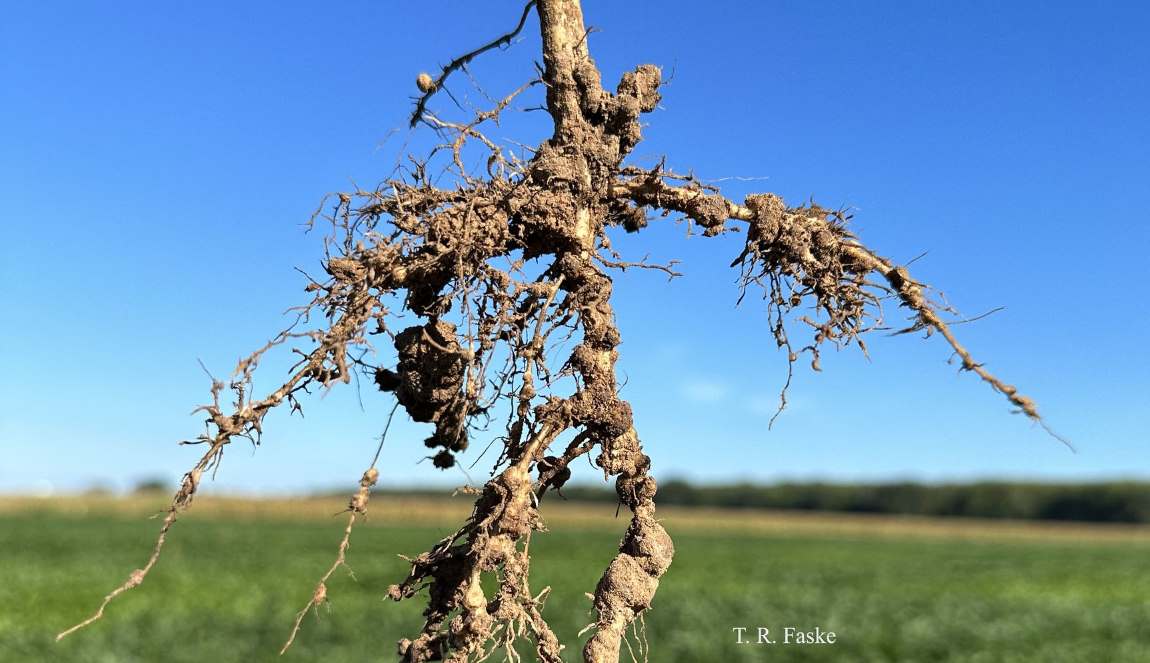Microscopic but mighty, plant-parasitic nematodes are responsible for $160 billion in agricultural losses worldwide every year. Among the most destructive is the southern root-knot nematode, Meloidogyne incognita, which damages soybean crops across the United States.
A $791,000 grant from the U.S. Department of Agriculture is now supporting a research effort led by Caio Canella Vieira of the Arkansas Agricultural Experiment Station to develop soybean varieties resistant to this pathogen. This initiative aims to shield farmers from severe yield losses and mitigate the pest’s spread into northern regions.
Jenifer Fouch | University of Arkansas System Division of Agriculture – Causing an estimated $160 billion in damages globally each year, one of agriculture’s biggest enemies is too small to see without a microscope.
Plant-parasitic nematodes feed on agricultural crops at their roots, reducing yields and profits for producers. In the U.S., soybean producers lose about 11 percent of their crops to soybean diseases, including the southern root-knot nematode, Meloidogyne incognita, or SRKN as it’s commonly known. The nematode forms abnormal growths – or knots – in soybean plant roots that disrupt water and nutrient uptake, essentially starving the plants.

According to the Crop Protection Network, U.S. producers suffered approximately $172 million in damages due to SRKN in 2023. More than half of those damages occurred in Arkansas, where producers lost approximately $95 million.
Caio Canella Vieira, a researcher for the Arkansas Agricultural Experiment Station and assistant professor of soybean breeding, is leading a new project to develop resilient soybean plants and prevent SRKN from gaining a foothold in producers’ fields.
“We want to develop soybean lines that are resistant to this pathogen so farmers have effective tools to manage SRKN and protect their crops,” Vieira said.
Vieira received a three-year, $791,000 U.S. Department of Agriculture National Institute of Food and Agriculture grant to conduct this research. The experiment station is the research arm of the University of Arkansas System Division of Agriculture.
Moving north
Soybean plants in Southern states have developed some resistance to these microscopic pests over time, Vieira said. However, these nematodes have recently been crawling northward into areas where soybean plants are highly susceptible.
“With changes in climate patterns and how farmers are adopting earlier planting dates and using earlier maturing soybeans, the problem has been expanding,” he said. “There are occurrences of southern root-knot nematode in Illinois, northern Missouri, and Indiana, for example. And this can become a serious threat over the next few years.”
Southern root-knot nematode is the second most destructive soybean pathogen, only behind soybean cyst nematodes.
“Historically, the research community emphasized the soybean cyst nematode because it was more broadly distributed across the country. But now, with southern root-knot expanding, it started to gain attention,” Vieira said.
Soybean plants affected by southern root-knot nematodes will show stunted growth, leaf wilting and discoloration, and deformation of roots. These symptoms can easily be mistaken for abiotic stress, such as drought or nutrient deficiency, leading to misdiagnosis and ineffective management strategies. Vieira says farmers may experience loss without ever seeing any symptoms.
The nematodes’ short life cycle and high reproductive rates also make management a challenge.
The root of the problem
Standard management practices such as crop rotation and chemical treatments have limited efficacy against SRKN, Vieira said.
In crop rotation, most flowering crops can still be hosts to SRKN. Chemical treatments can be expensive, require specialized equipment and can be toxic to the environment. Vieira said that a few options have been banned and the available options haven’t been very efficient.
“There’s no other management source for SRKN,” he said. “Genetic resistance is the most sustainable approach to managing the problem and sustaining soybean production.”
Previous research showed that yield losses in susceptible crops are 25 to 30 percent higher than in resistant crops. If extremely high pressure is present, meaning more nematodes in the soil, it’s a total loss.
But those earlier studies also had good news.
“Genetic resistance works as ‘crop insurance,” Vieira said. “If nematodes are present, the resistant genes will protect the crop. If no nematodes are present, the yield is unaffected.”
Genetic ‘crop insurance’
Vieira’s research has three main objectives:
- Identify the soybean gene that regulates resistance.
- Search for and identify new genetic sources and different modes of resistance.
- Develop soybean populations with improved genetic resistance by combining multiple sources of resistance.
“We know there is a resistant gene because we use this genomic region in current soybean breeding efforts, but we don’t know exactly what gene this is,” Vieira said. “The first step will be finding the causal gene, understanding its function, and how it interacts with the pathogen.”
The team will screen hundreds of genetically diverse soybean lines worldwide to identify potential new sources of resistance, including from China, South America, Europe, and Russia. They will then develop soybean breeding populations combining different genetic sources of resistance, aiming to create improved soybean varieties resistant to southern knot-root nematodes.
“The goal is to have resistant and high-performing soybean lines,” he said. “We want to expand our knowledge of SRKN but also develop tangible products available for farmers ready to grow.”
Collaborators in this project include the Division of Agriculture’s Travis Faske, extension plant pathologist and professor; Joanna Kud, assistant professor in the entomology and plant pathology department; and Henry Nguyen, professor of plant genetics and biotechnology at the University of Missouri.
This research also relies on the support of the United Soybean Board, the Mid-South Soybean Board, and the Arkansas Soybean Promotion Board.
***
This grant is part of the Agriculture and Food Research Initiative from USDA-NIFA. The project award no. is 2024-67014-43275.
About the Division of Agriculture
The University of Arkansas System Division of Agriculture’s mission is to strengthen agriculture, communities, and families by connecting trusted research to the adoption of best practices. Through the Agricultural Experiment Station and the Cooperative Extension Service, the Division of Agriculture conducts research and extension work within the nation’s historic land grant education system.
The Division of Agriculture is one of 20 entities within the University of Arkansas System. It has offices in all 75 counties in Arkansas and faculty on five system campuses.
Article Source:
Press Release/Material by University of Arkansas System Division of Agriculture
Featured image credit: U of A System Division of Agriculture | Photo by Travis Faske | CC BY-SA (cropped)




